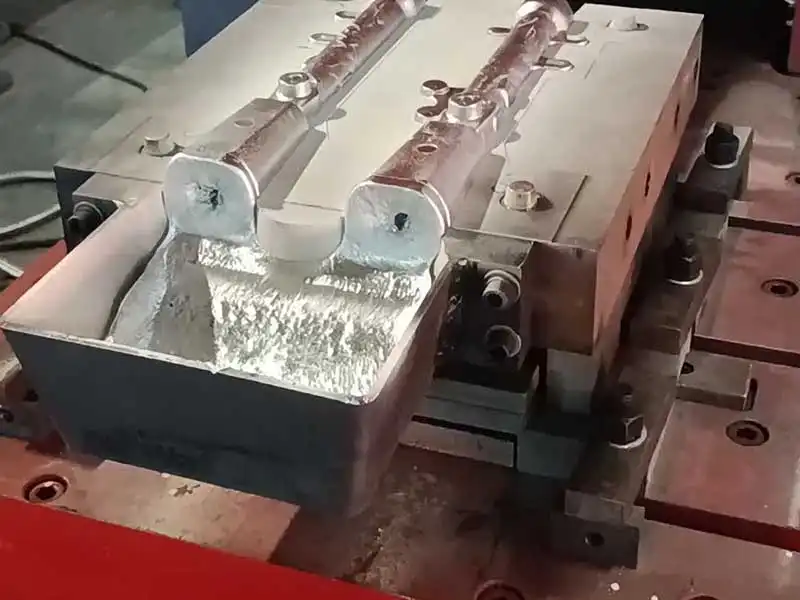Gravity die casting (GDC) is a permanent mold casting process that utilizes gravity to fill molten metal into a metallic mold cavity. Owing to its ability to produce components with superior mechanical properties, dimensional accuracy, and surface finish compared to sand casting, GDC has become an indispensable manufacturing method in the automotive, aerospace, and machinery industries.
This article systematically examines the principles of gravity die casting, the optimization of process parameters, its advantages and limitations, classifications, as well as recent industrial trends and applications, providing engineers and researchers with a comprehensive reference.
Fundamentals of Gravity Die Casting

What is Gravity Die Casting?
Gravity die casting is a permanent mold metal casting process in which molten metal is poured into a metallic mold and fills the cavity entirely under the influence of gravity, without the application of external pressure. It is also referred to as permanent mold casting, distinguishing it from expendable mold methods such as sand casting and from forced-fill techniques such as high-pressure die casting.
In this process, the mold—fabricated from high-temperature-resistant steel or cast iron—is reusable and precisely machined to the desired geometry. The molten metal, typically aluminum, magnesium, or copper-based alloys, is introduced into the mold either manually or via controlled pouring systems. After filling, the metal solidifies within the mold and forms a dense, fine-grained structure owing to the rapid heat extraction provided by the metallic surfaces.
The inherent simplicity of relying on gravity to fill the mold minimizes turbulence and entrapped gas, resulting in improved mechanical properties and dimensional accuracy of the casting. This makes gravity die casting particularly suited for medium- to high-volume production of components where strength, surface finish, and consistency are critical.
Basic Principles
In gravity die casting, molten metal is poured into a preheated metallic mold under the action of gravity. The metal fills the cavity, solidifies, and takes the shape of the mold. Unlike high-pressure die casting, no external pressure is applied; the process relies solely on gravity-induced flow.
Mold Materials and Design
Molds are typically fabricated from high-temperature resistant steel or cast iron, capable of withstanding repeated thermal cycling. Critical mold design considerations include adequate venting, gating system optimization, and incorporation of chills or risers to control solidification and avoid casting defects.
Comparison with Other Casting Methods
Compared with sand casting, gravity die casting achieves higher dimensional accuracy, better surface finish, and enhanced mechanical properties due to rapid heat extraction. However, unlike high-pressure die casting, production rates are lower, and thin-walled complex geometries are less feasible.
Classifications of Gravity Die Casting
Based on the orientation and movement of the mold during pouring, gravity die casting can be divided into two principal types: tilting (inclined) gravity die casting and vertical gravity die casting. Each type has distinct process characteristics, advantages, and limitations.
Tilting Gravity Die Casting
In tilting gravity die casting, the mold is mounted on a rotating axis and gradually tilted during the pouring process. This controlled tilting allows the molten metal to flow smoothly and progressively into the cavity.
Advantages:
- Reduces turbulence during mold filling, minimizing oxide formation and gas entrapment.
- Produces castings with superior internal soundness and reduced porosity.
- Particularly suitable for large, thick-walled components that require high structural integrity.
Limitations:
- Requires specialized tilting equipment, increasing installation complexity and cost.
- Slower cycle times compared to vertical casting due to the controlled motion.
- Less efficient for high-volume production of simple shapes.
Vertical Gravity Die Casting
In vertical gravity die casting, the mold remains stationary in a vertical orientation, and molten metal is poured directly from the top into the mold cavity.
Advantages:
- Equipment is relatively simple and compact, making it cost-effective.
- Well-suited for high-volume production of parts with symmetric or simple geometries.
- Faster cycle times compared to the tilting method.
Limitations:
- Higher filling velocity and turbulence may lead to increased porosity or inclusions.
- Less suitable for large or complex shapes requiring controlled filling.
These two methods are selected based on the specific requirements of the casting, such as size, complexity, mechanical property demands, and production volume.
Process Parameters and Optimization
Critical Parameters
Key parameters influencing casting quality include:
- Pouring temperature: Excessively high temperature leads to oxidation and porosity; too low can cause misruns or cold shuts.
- Mold temperature: Preheating ensures uniform solidification and prevents premature chilling.
- Metal head height: Influences filling velocity and reduces turbulence.
Mold Coating and Preheating
Mold coatings serve as thermal barriers and lubricants, improving surface finish and facilitating demolding. Preheating the mold minimizes thermal shock and promotes directional solidification.
Defect Prevention
Common defects such as shrinkage cavities, gas porosity, and cold shuts can be mitigated through appropriate gating design, controlled solidification rates, and use of vacuum-assisted methods or inert gas shielding when applicable.
Advantages of Gravity Die Casting
Gravity die casting offers a range of technical and economic benefits that make it an attractive choice for manufacturing high-quality metal components. Its key advantages include:
- Superior Mechanical Properties: The dense, fine-grained structure achieved through rapid solidification imparts excellent strength and fatigue resistance to the casting.
- Enhanced Dimensional Accuracy and Repeatability: Permanent metallic molds ensure consistent tolerances and reduce the need for extensive machining.
- Improved Surface Finish: The smooth surfaces of the metallic mold contribute to excellent surface quality, often eliminating or minimizing finishing operations.
- Cost Efficiency for Medium-to-High Volumes: While initial mold costs are higher, the durability and reusability of the molds reduce per-unit costs over time.
- Reduced Porosity and Better Integrity: The controlled, low-turbulence filling minimizes gas entrapment and shrinkage, resulting in sound castings.
- Environmental Benefits: The process generates less waste compared to expendable mold methods, and the alloys used are often recyclable.
Limitations of Gravity Die Casting
Despite its many advantages, gravity die casting also exhibits certain limitations that must be considered in process selection:
- High Initial Tooling Costs: The production of precise, durable metallic molds requires significant upfront investment.
- Geometrical Constraints: Thin-walled, highly intricate shapes are challenging to produce due to the reliance on gravity-driven filling.
- Lower Production Rate Compared to High-Pressure Die Casting: Cycle times are longer, making it less suitable for extremely high-volume production scenarios.
Industrial Applications
Gravity die casting is widely employed in manufacturing critical components, particularly in aluminum and copper-based alloys. Notable applications include:
- Automotive: Engine cylinder heads, gearbox housings, wheels
- Aerospace: Structural components, brackets
- Energy sector: Pump housings, turbine components
- General machinery: Valves, pipe fittings
Case studies have demonstrated that components produced via GDC exhibit excellent fatigue strength and dimensional stability, making it a preferred choice where reliability is paramount.
Recent Developments and Trends
Emerging technologies are further enhancing the gravity die casting process:
- Application of computer-aided simulation tools to predict metal flow and solidification
- Integration of automation and robotics for improved consistency and productivity
- Development of advanced coatings to prolong mold life
- Focus on sustainable practices, including energy-efficient furnaces and alloy recycling
These innovations enable manufacturers to meet stringent quality, environmental, and cost objectives.
Conclusion
Gravity die casting remains a robust and reliable manufacturing process for producing medium-to-large quantities of high-quality metal components. Its inherent advantages of improved mechanical properties, repeatability, and surface finish make it indispensable in many industrial sectors. Continuous research and technological advancements are addressing its limitations, ensuring its relevance in modern manufacturing landscapes.
Frequently Asked Questions (FAQ)
What is the main difference between gravity die casting and high-pressure die casting?
Gravity die casting relies solely on gravity for metal filling, resulting in slower filling speeds and reduced turbulence, which leads to better structural integrity. High-pressure die casting uses external force to fill the mold quickly, enabling thinner walls but often at the expense of porosity and lower mechanical strength.
Which materials are suitable for gravity die casting?
Common materials include aluminum alloys, magnesium alloys, and copper-based alloys. Steel and cast iron are generally not suitable due to their high melting points.
How does mold preheating influence casting quality?
Preheating ensures uniform thermal gradients, reduces the risk of hot tearing, and promotes better surface quality by avoiding premature chilling and sticking of the metal to the mold surface.
What are typical defects in gravity die casting, and how are they prevented?
Typical defects include gas porosity, shrinkage cavities, cold shuts, and oxide inclusions. Prevention strategies include optimizing the gating system, controlling pouring and mold temperatures, using proper venting, and applying protective atmospheres if necessary.
Is gravity die casting environmentally friendly?
Compared to expendable mold processes, GDC generates less waste due to reusable molds. Recent developments in energy-efficient furnaces, alloy recycling, and reduced emissions further improve its environmental performance.


